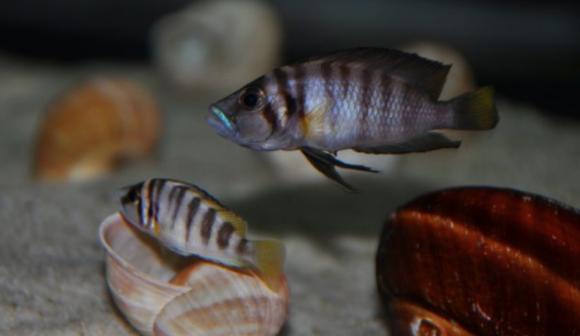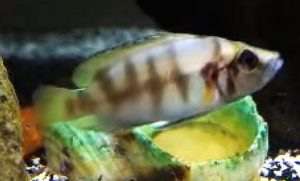Dwarf Sumbu Shell Compressiceps Cichlid (Altolamprologus compressiceps sp.) “Sumbu Shell” is also known to tropical fish keeping enthusiasts as the Sumbu Shell, Sumbu Dwarf Compressiceps, or Sumbu Shell Compressiceps and is found in the southernmost tip of Lake Tanganyika around Ndole Bay near Zambia, Africa.
Dwarf Sumbu Shell Compressiceps have a high back, laterally compressed body shape with eight dark horizontal stripes over a dark brown to red, yellow, or rusty orange body.
They have a deep mouth and as they mature the ends of their dorsal, pectoral, and caudal fins turn yellow to yellow/orange. Both sexes are identical in color but males are twice to two thirds larger than females, and can grow to almost 3.5″ in their natural habitat. Just prior to spawning, females will develop a more rounded belly.
The Dwarf Sumbu Shell Compressiceps is a natural shell dweller which inhabit and breed in Neothauma tanganyicense shells.
Dwarf Sumbu Shell Compressiceps do best in a long aquarium of at least 20 gallon capacity, with a sand or fine gravel substrate decorated with rock piles and plenty of Neothauma tanganyicense (or similar) shells. Anubias spp. can be added for decoration but is not necessary. Water quality is important and 20% of total volume water changes should be considered mandatory for this species.
This species is best housed in pairs or one male with two females. These fish are very aggressive towards each other, and although they tend to leave other tank mates alone, they can become extremely aggressive to other species during spawning.
All Altolamprologus species are secretive substrate spawners that lay their eggs in a shell, cave, or even a flowerpot too small for the male to enter.
Dwarf Sumbu Shell Compressiceps are considered difficult to spawn in an aquarium environment, primarily because they take such a long time to reach breeding age.
Dwarf Sumbu Shell Compressiceps usually form pairs and will spawn in Neothauma tanganyicense shells. They often practice polygamy if an excess of females are present in the breeding tank.
The Neothauma tanganyicense shells are for the female to retreat into and lay her eggs in, and should be just large enough for the female to almost fit.
The female will pick out one particular shell to use as her “home” and when ready to spawn, the pair will turn a dark (almost black) color as the male displays himself to the female in front of the female’s shell.
When the female deposits her eggs, the male will fertilize them, and she will then guard the opening to prevent the male from eating the eggs.
After spawning occurs, the female will remain in her shell for a week or more guarding the eggs. During this period she will not eat. The male does not usually harass the female during this period.
Until hatching occurs the female is the sole caregiver of anywhere from 15 to 25 fry. Once the fry are released from the shell, both parents basically ignore the fry and will normally not eat them.
The fry are light colored, cylindrical shaped, and can be fed a combination of crushed flake food, newly hatched brine shrimp, microworms, etc. when they are noticed in the tank and do not require any other special care.
Dwarf Sumbu Shell Compressiceps feed on invertebrates, crustaceans, and smaller fish in their natural habitat and are relatively easy to feed in an aquarium environment. They will accept live, frozen, or freeze dried brine shrimp, bloodworms, tubifex, chopped earthworms, etc.
Although they will devour fish smaller than themselves, live feeder fish are not recommended due to the possibility of parasite transmission.
Dwarf Sumbu Shell Compressiceps (Altolamprologus compressiceps sp.) “Sumbu Shell” are not common in the aquarium trade and when available demand a premium. They can be purchased from tropical fish keeping enthusiasts on Cichlid forums online, from specialty tropical fish shops, auction sites, and importers when they are 1.25″ to 1.5″ or more in size.
Minimum Tank Size: 20 gallons
Care Level: Moderately easy
Temperament: Semi aggressive
Aquarium Hardiness: Moderately hardy
Water Conditions: 76-82° F, pH 7.6-8.6, GH 7-11°
Max. Size: 3″
Color Form: Blue
Diet: Carnivore
Compatibility: Best kept in single species tanks
Origin: Lake Tanganyika, Africa
Family: Cichlidae
Lifespan: 10 years
Aquarist Experience Level: Advanced




